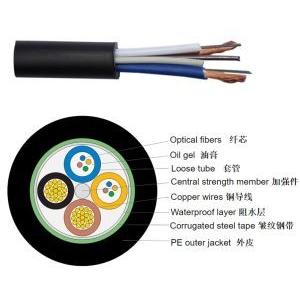
Add to Cart
1-144 cores OPLC Hybrid Fiber Optic Cable
| Cores available | 2,4,6,8,12,24,36,48,72,96,144 |
| Outer diameter | Vary from 7 to 15mm |
| RV copper wires | RV0.5,1.0,1.5,2.0,2.5 sq.mm |
| Application | Aerial ,duct, pipeline, underground |
| Cores type | G652D,G657A,G655C |
| Attenuation @1310nm | ≤0.36dB/km |
| Attenuation @1550nm | ≤0.22dB/km |
| OEM/ODM | Yes |
| Package | 1/2km km each exporting wooden drums |
| Cover | PE,HDPE |

Learn more about fiber optic cable:
From the trunk cables, smaller distribution cables are connected to a port of the trunk amplifier to carry the RF signal and the AC power down individual streets. If needed, line extenders, which are smaller distribution amplifiers, boost the signals to keep the power of the television signal at a level that the TV can accept. The distribution line is then "tapped" into and used to connect the individual drops to customer homes.
These taps pass the RF signal and block the AC power unless there are telephony devices that need the back-up power reliability provided by the coax power system. The tap terminates into a small coaxial drop using a standard screw type connector known as an F connector.
The drop is then connected to the house where a ground block protects the system from stray voltages. Depending on the design of the network, the signal can then be passed through a splitter to multiple TVs. If too many splitters are used to connect multiple TVs, the signal levels will decrease, and picture quality on analog channels of TVs past those splitters will go down requiring the use of a "drop" or "house" amplifier, or more crudely, multiple drops to the same building.
Transport over HFC network
By using frequency-division multiplexing, a HFC network may carry a variety of services, including analog TV, digital TV (SDTV or HDTV), video on demand, telephony, and high-speed data. Services on these systems are carried on RF signals in the 5 MHz to 1000 MHz frequency band.
The HFC network is typically operated bi-directionally, meaning that signals are carried in both directions on the same network from the headend/hub office to the home, and from the home to the headend/hub office. The forward-path or downstream signals carry information from the headend/hub office to the home, such as video content, voice and Internet data. The very first HFC networks, and very old unupgraded HFC networks, are only one-way systems. Equipment for one-way systems may use POTS or radio networks to communicate to the headend.